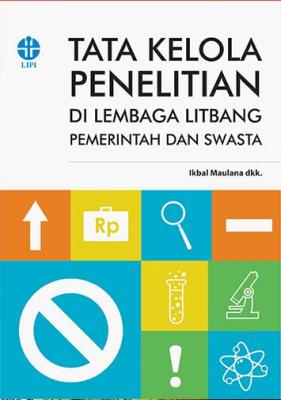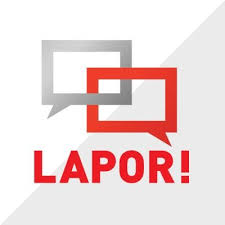Tata Kelola Penelitian di Lembaga Litbang Pemerintah dan Swasta
Keywords:
Tata Kelola, Lembaga LitbangSynopsis
Mengapa perlu ada tata kelola penelitian di lembaga litbang? Tidakkah para peneliti perlu diberi kebebasan akademis untuk menentukan arah serta bagaimana melakukan penelitian? Bukankah akan sulit bagi pihak lain, yang tidak menekuni bidang ilmu yang diteliti, untuk menilai kualitas suatu penelitian? Pertanyaan-pertanyaan inilah yang coba dijawab dalam buku ini, serta dilihat bagaimana persoalan kualitas dihadapi dan ditangani oleh lembaga penelitian pemerintah maupun swasta yang ada di Indonesia. Kebutuhan akan tata kelola muncul akibat adanya asimetri informasi antara pihak agen dan pihak prinsipal. Prinsipal menyerahkan dana untuk digunakan agen, namun prinsipal tidak bisa sepenuhnya mengetahui apakah agen benar-benar bekerja untuk memenuhi kepentingan prinsipal. Tata kelola dikembangkan untuk meningkatkan jaminan agar agen bekerja demi kepentingan prinsipal. Dalam kasus penelitian, yang melemahkan kualitas penelitian adalah prinsipal tidak memposisikan diri sebagai pihak yang berkepentingan terhadap penelitian yang berkualitas. Karena itulah tata kelola yang berkembang dan dipraktikkan lebih banyak muncul dari inisiatif lembaga-lembaga litbang itu sendiri. Dan, buku ini juga menunjukkan bahwa ketatnya tata kelola penelitian yang dipraktikkan sangat tergantung pada keberadaan pihak luar yang menjadi penyandang dana sekaligus berkepentingan mendapatkan hasil kepentingan yang berkualitas.
Downloads
References
Barney, J.B. 1991. “Firm Resources and Sustained Competitive Advantage”. Journal of Management, 17(1), 99-120.
Barney, J.B. 1996. Gaining and Sustaining Competitive Advantage. Reading, MA: Addison Wesley.
Bart, C. & Turel, O., 2010. “IT and the Board of Directors: An Empirical Investigation into the “Governance Questions” Canadian Board Members Ask about IT”. Journal of Information Systems, 24(2): 147–172.
Bekier, M.M., Berger, L.W., & Wilson, G.P. 2004. “Broadening Indonesia’s Reform Agenda: Investors are Returning to the Country, but will ey Remain?”. McKinsey Quarterly, 3.
Biddle, J. 2011. “Bringing the Marketplace into Science: On the Neoliberal Defense of the Commercialization of Scienti c Research”. Dalam M. Carrier & A. Nordmann (Ed.). Science in the Context of Application. Dordrecht, e Netherlands: Springer.
Brown, M.G., & Svenson, R.A. 1998. “Measuring R&D Productivity”. Research Technology Management, Nov/Dec, 41(6).
Carrier, M. 2011. “Knowledge, Politics, and Commerce: Science under the Pressure of Practice”. Dalam M. Carrier & A. Nordmann (Ed.). Science in the Context of Application. Dordrecht, e Netherlands: Springer.
Clough, E. 2002. “Putting Governance into Research and Development”. British Journal of Clinical Governance, 7(1).
Charkham, J.P. 2005. Keeping Better Company: Corporate Governance Ten Years On. Oxford: Oxford University Press.
Department of Health. 2005. Research Governance Framework for Health and Social Care, Second Edition. Departemen Kesehatan Pemerintah Inggris.
Eisenhardt, K.M. 1989. “Building eories From Case Study Research .” e Academy of Management Review, 14(4).
Eisenhardt, K.M. & Martin, J.A. 2000. “Dynamic Capabilities: What Are ey?”. Strategic Management Journal, 21: 1105–21.
Fahy , M., Jeremy Roche, J. & Weiner, A. 2004. Beyond Governance: Creat- ing Corporate Value through Performance, Conformance and Responsibility. West Sussex, England: John Wiley & Sons Ltd .
Gla?ser, J. 2007. “ e Social Orders of Research Evaluation Systems”. Dalam R. Whitley & J. Gla?ser (Ed.). e Changing Governance of the Sciences: e Advent of Research Evaluation Systems. Dordrecht, e Netherlands: Springer.
Had eld, G.K. 2005. “ e Many Legal Institutions that Support Contractual Commitments”. Dalam C. Menard & M.M. Shirley (Eds.). Handbook of New Institutional Economics. Dordrecht, e Netherlands: Springer.
Kehm, B.M. & Leiðyte?, L. 2010. “E ects of New Governance on Research in the Humanities- e Example of Medieval History”. Dalam D. Jansen (Ed.). Governance and Performance in the German Public Research Sector: Disciplinary Di erences, Dordrecht, Holland: Springer.
Jansen, D., 2010. “Governance of Research, Inter-disciplinary Di erences and Performance – An Introduction to the Research Programme and the Contributions”. Dalam D. Jansen (Ed.). Governance and Performance in the German Public Research Sector: Disciplinary Di erences, Dordrecht, Holland: Springer.
Jansen, D. (Ed.). 2010a. Governance and Performance in the German Public Research Sector: Disciplinary Di erences, Dordrecht, Holland: Springer.
Jansen, D. 2010b. “Summary and Conclusions”. Dalam D. Jansen (Ed.).
Governance and Performance in the German Public Research Sector: Dis- ciplinary Di erences, Dordrecht, Holland: Springer.
Jansen, D., von Go?rtz, R. & Heidler, R. 2010. “Is Nanoscience a Mode 2 Field? Disciplinary Di erences in Modes of Knowledge Production”. Dalam D. Jansen (Ed.). Governance and Performance in the German Pub- lic Research Sector: Disciplinary Di erences, Dordrecht, Holland: Springer.
Klein, P.G. 2005. “ e Make-or-Buy Decision: Lessons from Empirical Studies”. Dalam C. Menard & M.M. Shirley (Eds.). Handbook Of New Institutional Economics. Dordrecht, e Netherlands: Springer.
Kuhn, T.S. 1962 [1970]. e Structure of Scienti c Revolutions. 2nd ed. Chi- cago, IL: University of Chicago Press.
Marnet, O. 2008. Behaviour and rationality in corporate governance. New York, NY: Routledge.
Menard, C. 2005. “A New Institutional Approach to Organization”. Dalam C. Menard & M.M. Shirley (Eds.). Handbook Of New Institutional Economics. Dordrecht, e Netherlands: Springer.
Miller, G.J. 2005. “Solutions to Principal-Agent Problems in Firms”. Dalam C. Menard & M.M. Shirley (Eds.). Handbook Of New Institutional Economics. Dordrecht, e Netherlands: Springer.
Penrose, E.T. 1959. e eory of the Growth of the Firm. New York: John- Wiley & Sons.
Rip, A. 2011. “Protected Spaces of Science: eir Emergence and Further Evolution in a Changing World”. Dalam M. Carrier & A. Nordmann (Ed.). Science In e Context Of Application. Dordrecht, e Nether- lands: Springer.
Robinson, H., Carillo, P., Anumba, C.J. & Patel, M. 2010. Governance & Knowledge Management for Public-Private Partnerships. Oxford, UK: Wiley-Blackwell.
Schubert, T. & Schmoch, U. 2010. “New Public Management in Science and Incentive-Compatible Resource-Allocation Based on Indicators”. Dalam D. Jansen (Ed.). Governance and Performance in the German Public Research Sector: Disciplinary Di erences, Dordrecht, Holland: Springer.
Shleifer, A. & Vishny, R.W. 1997. “A Survey of Corporate Governance”. e Journal of Finance, 52(2).
Spiller, P.T. & Tommasi, M. 2005. “ e Institutions of Regulation: An Ap- plication to Public Utilities”. Dalam C. Menard & M.M. Shirley (Eds.). Handbook Of New Institutional Economics. Dordrecht, e Netherlands: Springer.
Teece, D., Pisano, G., & Shuen, A. 1997. “Dynamic Capabilities and Stra- tegic Management”. Strategic Management Journal, 18: 509–33.
Whitley, R. 2007. “Changing Governance of the Public Sciences”. Dalam R. Whitley & J. Gla?ser (Ed.). e Changing Governance of the Sciences: e Advent of Research Evaluation Systems. Dordrecht, e Netherlands: Springer.
Wilholt, T. & Glimell, H. 2011. “Conditions of Science: e ree-Way Tension of Freedom, Accountability and Utility”. Dalam M. Carrier & A. Nordmann (Ed.). Science in the Context of Application. Dordrecht, e Netherlands: Springer.
Williamson, O.E. 1996. e Mechanisms of Governance. New York, Oxford. Yin, R.K. 2003. Case Study Research: Design and Methods (Second edition).
ousand Oaks, CA: Sage Publications.

Downloads
Published
Series
Categories
License

This work is licensed under a Creative Commons Attribution-NonCommercial-ShareAlike 4.0 International License.






























